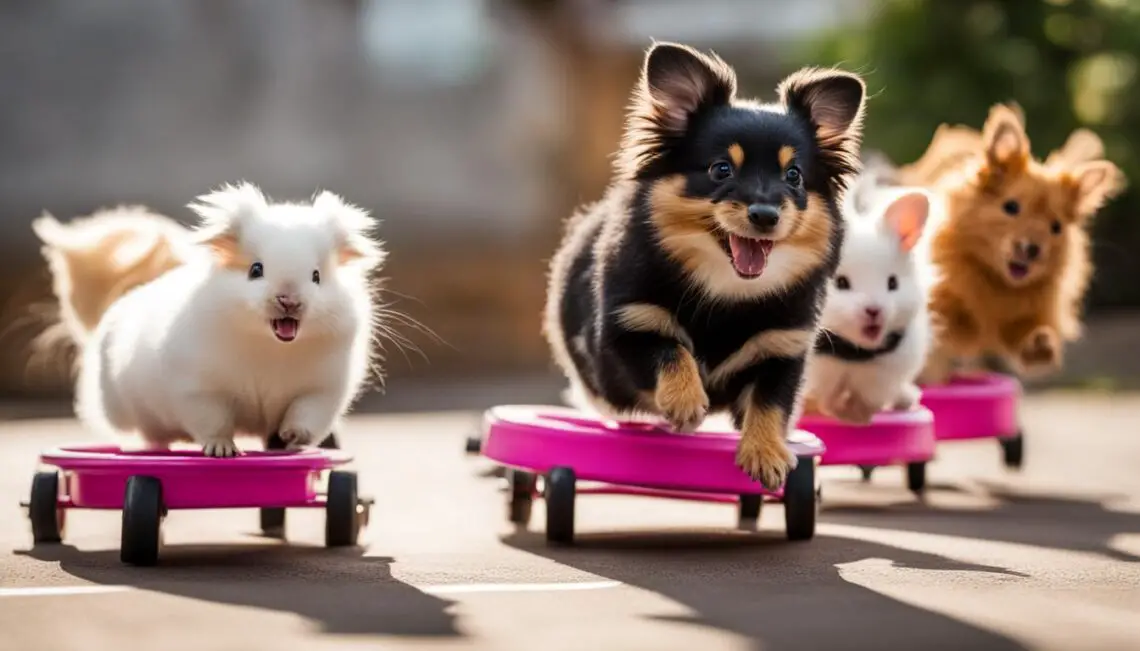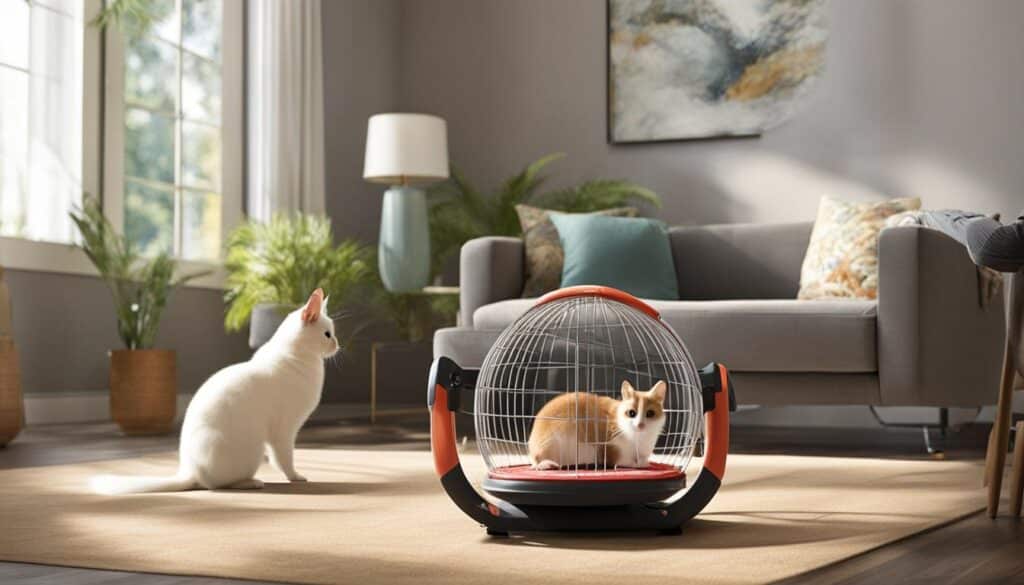Training small pets to exercise on an exercise wheel is not only a fun activity but also beneficial for their physical and mental health. Whether you have a cat or a small rodent like a rat, introducing an exercise wheel can provide them with the opportunity to burn off energy and stimulate their minds.
One Fast Cat’s exercise wheel, designed specifically for cats weighing up to 25 lbs, has garnered praise from veterinarians for its potential to improve feline well-being. However, it’s important to approach training with caution to ensure the safety and comfort of your furry friend.
Key Takeaways
- Training small pets on exercise wheels promotes physical activity and mental stimulation.
- Choose the right wheel size and materials based on your pet’s needs and preferences.
- Start training gradually and use positive reinforcement techniques.
- Supervise your pet during exercise wheel sessions and maintain regular maintenance.
- Consult a veterinarian if your pet shows signs of discomfort or unusual behavior.
The Benefits of Exercise Wheels for Small Pets
Exercise wheels provide numerous benefits for small pets, including small pet exercise, improved health, and mental stimulation. They can play a crucial role in addressing the exercise needs of indoor cats and other small pets, preventing obesity and promoting overall well-being.
Promoting Physical Activity and Burning Calories
Indoor cats often face limited opportunities for physical activity, which can lead to weight gain and various health issues. Exercise wheels offer a great solution by providing a means for cats to engage in natural running and burning calories within the confined space of a home environment. Regular use of the wheel helps cats to stay active, maintain a healthy weight, and reduce the risk of obesity-related complications.
Mental Stimulation and Enrichment for Small Pets
Exercise wheels are not limited to cats; they also offer mental stimulation and enrichment for other small pets like rats. Small animals thrive on mental engagement and need activities that challenge their minds. Running on an exercise wheel allows them to engage in a natural behavior, satisfying their instinctual need for physical exertion while also providing mental stimulation.
“Exercise wheels are a fantastic investment for small pet owners. They offer a way for indoor cats to get the exercise they need and help prevent mental and physical health issues caused by sedentary lifestyles. Rats, in particular, greatly benefit from the mental stimulation and enrichment provided by exercise wheels.”
By using exercise wheels, small pet owners can promote the well-being of their furry companions by addressing their exercise needs and enhancing their mental and physical health.
Choosing the Right Exercise Wheel for Your Small Pet
When it comes to selecting an exercise wheel for your small pet, there are a few important factors to consider. The size and weight of your pet, as well as the materials used in the wheel, play a crucial role in ensuring their safety and comfort during exercise. Whether you have a cat or a rat, choosing the right wheel is essential for providing them with an enjoyable and beneficial workout.
Selecting the Suitable Size
If you have a cat, it’s essential to choose an exercise wheel that can support their weight and provide enough space for comfortable running. Cats come in different sizes, so make sure to consider the dimensions of the wheel before making a purchase. Opt for a wheel that allows your feline friend to stretch out and run without feeling cramped or restricted.
For rats, on the other hand, larger wheels are preferable to accommodate their size. Rats are agile climbers and prefer wheels that offer ample space for them to move around. A too-small wheel may cause discomfort or restrict their movements, leading to potential injuries.
Materials Matter
When it comes to exercise wheel materials, it’s crucial to choose options that prioritize the safety and well-being of your furry friend. Opt for wheels made from non-toxic and pet-friendly materials that won’t cause harm or discomfort during use. Avoid wheels with sharp edges or rough surfaces that can potentially injure your pet.
Choosing the right size and materials can make a significant difference in the overall exercise experience for your small pet. Take the time to research and select a wheel that meets their specific needs, ensuring their safety and well-being.
By carefully selecting an exercise wheel that suits your pet’s size and weight and is made from safe materials, you can provide them with a comfortable and enjoyable exercise experience. Remember, their well-being should always be the top priority when selecting any pet equipment.
https://www.youtube.com/watch?v=02FL092Qk_k
| Size | Recommended Pets |
|---|---|
| Small | Hamsters, Mice |
| Medium | Gerbils, Dwarf Hamsters, Rats |
| Large | Cats, Chinchillas, Ferrets |
Training Small Pets to Use Exercise Wheels
Training small pets to use exercise wheels requires a patient and positive approach. By gradually introducing the wheel and using positive reinforcement, you can help your pet become comfortable and enjoy their exercise sessions. Here are some training tips to get you started:
1. Gradual Introduction
Start by placing the exercise wheel in your pet’s environment and allowing them to explore it at their own pace. Avoid forcing them onto the wheel or rushing the process. Encourage curiosity by placing treats or toys near the wheel to attract their attention.
2. Encouragement and Rewards
Once your pet becomes comfortable with the exercise wheel, take the next step by enticing them to approach and eventually step onto it. Use treats or toys as positive reinforcement, rewarding them with praise and treats for making any progress. This will associate the wheel with positive experiences and encourage further exploration.
3. Gradually Increase Training Sessions
As your pet becomes more confident using the exercise wheel, gradually increase the length and frequency of their training sessions. Start with short sessions and slowly increase the time as they become more comfortable. This gradual approach helps build their confidence and ensures a positive experience.
“Positive reinforcement is the key to effective training. By rewarding your pet’s progress and making the training sessions enjoyable, you can create a positive association with the exercise wheel.”
Remember to be patient and consistent throughout the training process. Each pet learns at their own pace, so it’s important to tailor the training to their individual needs and abilities.
Regular training sessions and positive reinforcement will help your small pet become accustomed to using the exercise wheel. With time and patience, they will develop a healthy and enjoyable exercise routine that promotes their physical and mental well-being.
Ensuring Safety During Wheel Exercise Sessions
When it comes to wheel exercise sessions for your small pet, safety should always be a top priority. Here are some key safety precautions, supervision tips, and regular maintenance practices to keep in mind:
Safety Precautions
- Ensure that the exercise wheel is appropriate for your pet’s size and weight.
- Check the wheel regularly for any signs of damage, such as cracks or loose parts.
- Keep the wheel clean and free of debris that may cause accidents or discomfort.
Supervision is Crucial
Always supervise your small pet during exercise wheel sessions. This allows you to ensure their safety and step in if any issues arise. It also provides an opportunity for you to observe their behavior and make adjustments as needed.
Regular Maintenance
Regularly inspect the exercise wheel for wear and tear, and replace any worn-out or damaged parts. This helps to maintain its functionality and prevent potential injuries to your pet. Additionally, keep the area around the wheel clear to prevent accidental tripping or falling.
Remember, safety precautions, proper supervision, and regular maintenance are essential to create a safe environment during wheel exercise sessions for your small pet.
When to Seek Veterinary Advice
While exercise wheels can offer numerous benefits, it’s important to be aware of any signs of discomfort or unusual behavior in your small pet. If your pet shows reluctance to use the wheel, exhibits signs of pain or stress, or displays any unusual behavior, it’s recommended to consult a veterinarian for guidance and evaluation.
Conclusion
In conclusion, training small pets to use exercise wheels is an essential aspect of responsible pet ownership. These wheels provide physical and mental stimulation, contributing to the overall well-being of our furry companions. By following proper training techniques and ensuring safety precautions, we can create a healthy lifestyle and enhance the bond we share with our small pets.
Exercise is crucial for small pets, just as it is for humans. Regular physical activity helps prevent obesity, improves cardiovascular health, and increases muscle tone. Engaging in exercise wheel sessions allows our small pets to burn off excess energy and maintain a healthy weight, reducing the risk of various health issues.
Furthermore, exercise wheels offer mental stimulation, helping to prevent boredom and reduce stress and anxiety levels in our small pets. These wheels provide a constructive outlet for their natural instincts to run and explore, which is particularly important for indoor cats and small rodent pets.
As responsible pet owners, it is our duty to ensure our pets have the opportunity to exercise and stay mentally stimulated. By incorporating exercise wheel training into our routine, we can promote the well-being of our small pets and provide them with the enriching experiences they need to thrive.
FAQ
How do I train my small pet to use an exercise wheel?
Training small pets to use exercise wheels safely requires patience and positive reinforcement. Start by gradually introducing the wheel and allowing your pet to explore and become familiar with it. Use treats or toys to encourage them to approach and eventually step onto the wheel. Reward them with praise and treats for any progress. Gradually increase the training sessions to build their confidence and encourage regular use.
What are the benefits of exercise wheels for small pets?
Exercise wheels provide numerous benefits for small pets. They promote physical activity and burn calories, helping to prevent obesity and related health issues. For animals like rats, wheels offer mental stimulation and enrichment, reducing boredom, stress, and anxiety levels. Overall, exercise wheels contribute to improved well-being for small pets.
What should I consider when choosing an exercise wheel for my small pet?
When selecting an exercise wheel, consider your pet’s size and weight. For cats, choose a wheel that can support their weight and provides enough space for comfortable running. For rats and other smaller pets, opt for larger wheels to accommodate their size. It’s important to choose wheels made from safe materials that won’t cause harm or discomfort during use.
How can I ensure safety during exercise wheel sessions?
Supervision is crucial during exercise wheel sessions to ensure the safety of your small pet. Regularly check the wheel for any signs of damage or wear and tear. Keep the area around the wheel clear to prevent accidents. If using a laser pointer as an enticement, be cautious about potential obsessive behavior and provide other forms of mental stimulation. Always prioritize the safety and well-being of your pet during exercise wheel sessions.
When should I seek veterinary advice regarding exercise wheel use?
If your small pet shows reluctance to use the wheel, exhibits signs of pain or stress, or displays any unusual behavior, it’s recommended to consult a veterinarian for guidance and evaluation. Veterinarians can provide expert advice and support to ensure the well-being and health of your small pet.







No Comments